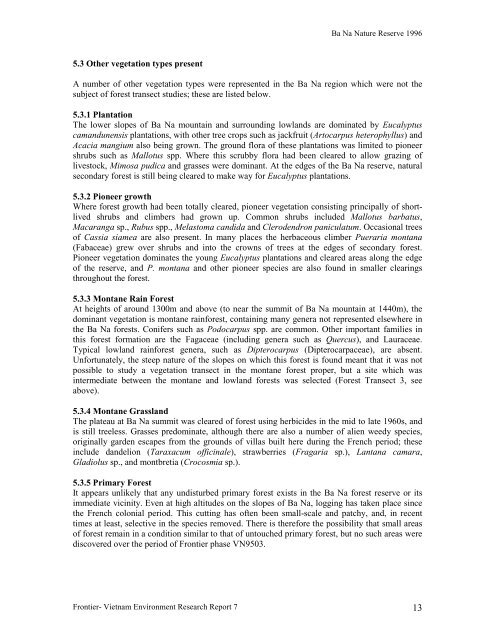Frontier Tanzania Environmental Research - Frontier-publications ...
Frontier Tanzania Environmental Research - Frontier-publications ...
Frontier Tanzania Environmental Research - Frontier-publications ...
You also want an ePaper? Increase the reach of your titles
YUMPU automatically turns print PDFs into web optimized ePapers that Google loves.
Ba Na Nature Reserve 1996<br />
5.3 Other vegetation types present<br />
A number of other vegetation types were represented in the Ba Na region which were not the<br />
subject of forest transect studies; these are listed below.<br />
5.3.1 Plantation<br />
The lower slopes of Ba Na mountain and surrounding lowlands are dominated by Eucalyptus<br />
camandunensis plantations, with other tree crops such as jackfruit (Artocarpus heterophyllus) and<br />
Acacia mangium also being grown. The ground flora of these plantations was limited to pioneer<br />
shrubs such as Mallotus spp. Where this scrubby flora had been cleared to allow grazing of<br />
livestock, Mimosa pudica and grasses were dominant. At the edges of the Ba Na reserve, natural<br />
secondary forest is still being cleared to make way for Eucalyptus plantations.<br />
5.3.2 Pioneer growth<br />
Where forest growth had been totally cleared, pioneer vegetation consisting principally of shortlived<br />
shrubs and climbers had grown up. Common shrubs included Mallotus barbatus,<br />
Macaranga sp., Rubus spp., Melastoma candida and Clerodendron paniculatum. Occasional trees<br />
of Cassia siamea are also present. In many places the herbaceous climber Pueraria montana<br />
(Fabaceae) grew over shrubs and into the crowns of trees at the edges of secondary forest.<br />
Pioneer vegetation dominates the young Eucalyptus plantations and cleared areas along the edge<br />
of the reserve, and P. montana and other pioneer species are also found in smaller clearings<br />
throughout the forest.<br />
5.3.3 Montane Rain Forest<br />
At heights of around 1300m and above (to near the summit of Ba Na mountain at 1440m), the<br />
dominant vegetation is montane rainforest, containing many genera not represented elsewhere in<br />
the Ba Na forests. Conifers such as Podocarpus spp. are common. Other important families in<br />
this forest formation are the Fagaceae (including genera such as Quercus), and Lauraceae.<br />
Typical lowland rainforest genera, such as Dipterocarpus (Dipterocarpaceae), are absent.<br />
Unfortunately, the steep nature of the slopes on which this forest is found meant that it was not<br />
possible to study a vegetation transect in the montane forest proper, but a site which was<br />
intermediate between the montane and lowland forests was selected (Forest Transect 3, see<br />
above).<br />
5.3.4 Montane Grassland<br />
The plateau at Ba Na summit was cleared of forest using herbicides in the mid to late 1960s, and<br />
is still treeless. Grasses predominate, although there are also a number of alien weedy species,<br />
originally garden escapes from the grounds of villas built here during the French period; these<br />
include dandelion (Taraxacum officinale), strawberries (Fragaria sp.), Lantana camara,<br />
Gladiolus sp., and montbretia (Crocosmia sp.).<br />
5.3.5 Primary Forest<br />
It appears unlikely that any undisturbed primary forest exists in the Ba Na forest reserve or its<br />
immediate vicinity. Even at high altitudes on the slopes of Ba Na, logging has taken place since<br />
the French colonial period. This cutting has often been small-scale and patchy, and, in recent<br />
times at least, selective in the species removed. There is therefore the possibility that small areas<br />
of forest remain in a condition similar to that of untouched primary forest, but no such areas were<br />
discovered over the period of <strong>Frontier</strong> phase VN9503.<br />
<strong>Frontier</strong>- Vietnam Environment <strong>Research</strong> Report 7 13
















